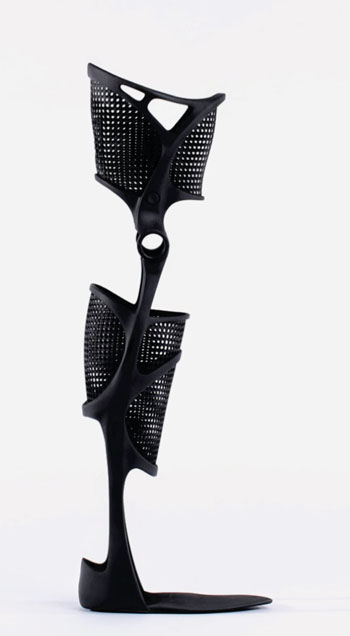3D-Printed Leg Brace Cost-Effectively Customized for a Just-Right Fit
By HospiMedica International staff writers
Posted on 08 Jul 2015
Braces or splints widely used to support legs that cannot take a person’s full weight are undergoing a design improvement makeover with 3-D printing. Posted on 08 Jul 2015
An “Objet1000 Multi-material 3D Production System” from Stratasys Ltd. (Minneapolis, MN, USA and Rehovot, Israel) was used by Or Steiner to modernize leg braces as his industrial design graduation project at the Shenkar College of Engineering and Design (Ramat Gan, Israel) after gaining experience there with 3-D printing technology while making models for product designs. Mr. Steiner met someone who had been in an accident that left him dependent on a wheelchair or braces in combination with crutches. But the braces were bulky, heavy, and ungainly. His vision for the redesign was to create personalized braces that were more functional as well as fashionable.

Image: 3D-printed on the Objet1000 Multi-material 3D Production System, the KAFO Splint is a customized, airy, and fashionable design for a medically functional leg brace, printed with “VeroBlack” rigid opaque PolyJet 3D printing material that provides the required weight-bearing support (Photo courtesy of Or Steiner and Stratasys).
The new design, currently called the “KAFO Splint,” is an airy, 3D-printed version of the original brace. There is enough solid material for the crucial stabilization, but the openness allows for airflow and lightness that traditional braces lack – and adding 3D scanning technology enables every KAFO Splint to be adapted to each patient’s body. “The main advantages are that it is customized and personalized to the user,” said Mr. Steiner, “The 3D print can look like a regular product that was created using injection molding, but it's actually custom made. The design possibilities are great, and the finished product can be very attractive.”
Mr. Steiner used the Objet1000 system to create the final product leveraging Stratasys’s “VeroBlack,” a rigid opaque PolyJet 3-D printing material. After months of trial sketches and designs, the final KAFO Splint was 3-D printed – in one piece. Despite the full “leg” extension of the design, the entire 3-D print was easily accommodated in the one-meter build tray of the Objet1000.
Related Links:
Stratasys
Shenkar College of Engineering and Design














